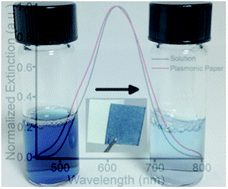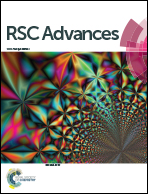Plasmonic paper: a porous and flexible substrate enabling nanoparticle-based combinatorial chemistry†
Abstract
The intrinsic properties of nanoparticles are both fundamentally interesting and offer tremendous potential for a variety of applications. However, leveraging their utility is difficult because these properties are often intimately connected to nanoparticle stability in solution. We report that cellulose filter paper is a versatile substrate to capture, stabilize, and manipulate nanoparticles. Once immobilized, we present ensemble averaged extinction spectra and propose that this plasmonic paper is a solid state equivalent to a nanoparticle solution. We also demonstrate that capillary flow within the paper creates concentration gradients of reagents for combinatorial chemical reactions on the immobilized nanoparticles. Importantly, the added stability afforded to the nanoparticles by the paper allows for exposure to chemical environments that would otherwise disrupt a nanoparticle colloid. These new capabilities could enable new architectures in nanoparticle-based sensors and biodiagnostics where many of the previous design limitations are entirely avoided.


 Please wait while we load your content...
Please wait while we load your content...